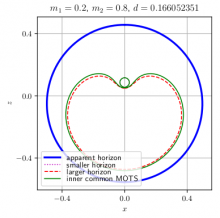
Abstract
Marginally outer trapped surfaces (MOTSs, or marginal surfaces in short) are routinely used in numerical simulations of black hole spacetimes. They are an invaluable tool for locating and characterizing black holes quasi-locally in real time while the simulation is ongoing. It is often believed that a MOTS can behave unpredictably under time evolution; an existing MOTS can disappear, and a new one can appear without any apparent reason. In this paper we show that in fact the behavior of a MOTS is perfectly predictable and its behavior is dictated by a single real parameter, the \emph{stability parameter}, which can be monitored during the course of a numerical simulation. We demonstrate the utility of the stability parameter to fully understand the variety of marginal surfaces that can be present in binary black hole initial data. We also develop a new horizon finder capable of locating very highly distorted marginal surfaces and we show that even in these cases, the stability parameter perfectly predicts the existence and stability of marginal surfaces.